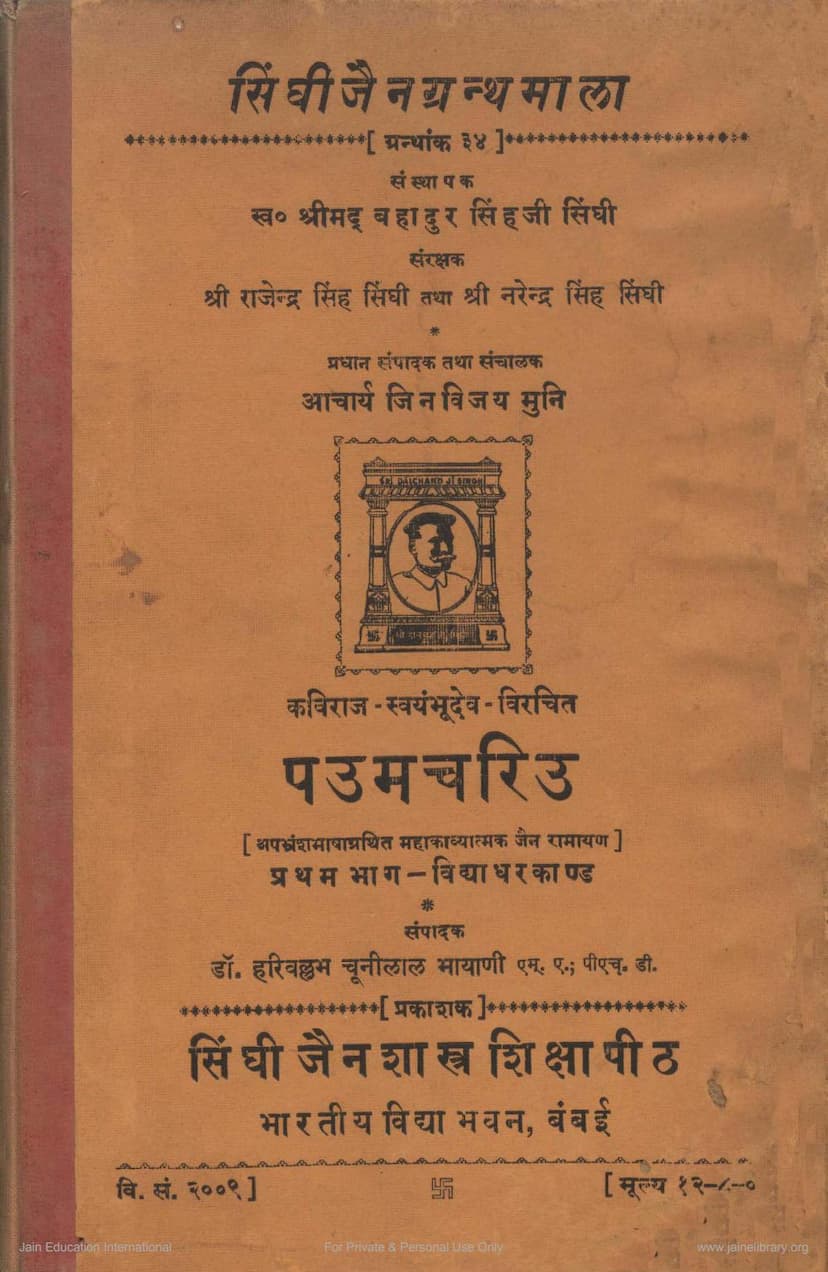Paumchariu Part 1
Added to library: September 2, 2025
Loading image...

Summary
Here is a comprehensive summary of "Paumchariu Part 1" by Swayambhudev, edited by H. C. Bhayani, published by Singhi Jain Granthamala (Volume 34), based on the provided text:
General Overview:
- Title: Paumchariu (meaning the life-story of Padma, i.e., Rama)
- Author: Kaviraja Swayambhudev (also known as Swayambhu)
- Genre: Apabhramsa Epic Poem (Mahakavya), a Jain adaptation of the Ramayana.
- Publisher: Singhi Jain Shastra Shikshapith, Bharatiya Vidya Bhavan, Bombay.
- Series: Singhi Jain Series, Volume 34.
- Date of Publication: Vikram Samvat 2009 (1953 AD).
- Content: This first part covers the Vidyadhara Kanda (Book of Vidyadharas), comprising the first 20 Sandhis of the epic.
- Significance: It is a foundational work in Apabhramsa literature, considered one of the earliest Puranic epics in the language. Swayambhudev is highly regarded as a Mahakavi (Great Poet) and Kaviraja (King of Poets) in Apabhramsa literature.
Key Aspects and Content:
-
The Singhi Jain Series:
- The series was established in memory of the saint-like Seth Sri Dalchandji Singhi of Calcutta.
- It is by his devoted son, Sri Bahadur Singh Singhi, and patronized by Sri Rajendra Singh Singhi and Sri Narendra Singh Singhi.
- Acharya Jinavijaya Muni serves as the Director and General Editor.
- The series aims to publish critical editions of important Jain canonical, philosophical, historical, literary, narrative, and scientific works in Prakrit, Sanskrit, Apabhramsa, and Old Gujarati-Rajasthani languages, along with new scholarly research.
- Babu Bahadur Singh Singhi was a significant patron of scholarship and played a pivotal role in inspiring and funding the publication of numerous works, including the Singhi Jain Series. His memoirs highlight his philanthropic activities, cultural interests, and support for Jain literature.
-
Swayambhudev:
- Date: Placed between the early 8th and late 9th centuries AD.
- Literary Activity: Besides the Paumchariu (Rama story) and Ritthanemicariu (Krishna story and life of Tirthankara Aristanemi), he also authored Svayambhu Chandas (a manual of Prakrit and Apabhramsa metres). Several other works are attributed to him but are lost.
- Authorship of Svayambhu Chandas: Confirmed by the title and citations. The work is divided into Prakrit and Apabhramsa sections, though the Prakrit section deals with Sanskrit metres and uses unique Mātrāgaņa terminology.
- Personal Life: His parents were Mauraeva and Padmini. He had at least two wives, Amiyavva and Aichamvia, who assisted him by dictating parts of his works. His son, Tribhuvana Swayambhudeva, completed some of Swayambhu's unfinished works, including the Paumchariu and Ritthanemicariu.
- Philosophy and Outlook: Swayambhudev's works exhibit a tolerant outlook, often equating the Supreme Deity with various deities from different religious systems (Narayana, Siva, Buddha, Hari, Arhat, etc.). He also omits or downplays anti-Brahmanical passages found in earlier Jain Ramayanas, indicating a more inclusive approach.
- Literary Achievements: He is celebrated for his mastery of Apabhramsa language, his poetic genius, and his comprehensive knowledge of Rhetorics, Metrics, Dramaturgy, Music, and Grammar. His works significantly influenced later Apabhramsa poets like Puspadanta and Dhanapala.
-
The Paumchariu:
- Title Variations: Also known as Ramayanam Purana, Ramadevacarita, and Ramacarita. "Paumchariu" is the most frequent and poet's intended title.
- Structure: Comprises 90 Sandhis divided into five Kandas (Books):
- Vidyadhara Kanda (20 Sandhis)
- Ayodhya Kanda (22 Sandhis)
- Sundara Kanda (14 Sandhis)
- Yuddha Kanda (21 Sandhis)
- Uttara Kanda (13 Sandhis)
- Sources: Primarily based on Raviṣena's Sanskrit Padmacarita, which itself is an elaboration of Vimalasūri's Prakrit Paümacariya. Swayambhu also incorporated material from other sources and demonstrated considerable originality in his literary embellishments, descriptions, and portrayal of sentiments. He significantly abridged or omitted lengthy sermons and certain anti-Brahmanical passages found in Raviṣena's work.
- Language and Style: Swayambhu's language is simpler, more direct, and less ornate than Puspadanta's. He is known for his masterful handling of Apabhramsa metres.
- Vidyadhara Kanda (Part 1): This volume contains the first 20 Sandhis, focusing on the Vidyadhara Kanda. The introduction provides detailed critical studies on:
- Critical Apparatus and Text-Constitution: Details the three manuscripts used (Poona MS., Samganer MS., Arner MS.), their descriptions, dating, and the critical process of text constitution, highlighting the superiority of the Arner MS.
- Date and Personal Account of Swayambhu: Discusses the fixation of Swayambhu's date and provides biographical details about his life and family.
- Literary Activity: Surveys Swayambhu's extant and lost works, discussing his achievements and influence on later poets.
- Sources of Paumchariu: Analyzes the relationship between Paumchariu and earlier works like Padmacarita and Paümacariya.
- Grammatical Peculiarities: Offers a detailed analysis of Apabhramsa orthography, phonetic changes, gender, affixes, stem formation, inflection, syntax, and idiomatic usages found in PC. I-XX.
- Metres: A comprehensive study of the metres employed in PC. I-XX, categorized by commencing piece, Ghattā (concluding piece), and main body metres, including Antarasamā Catușpadis, Sarvasamā Catușpadis, and Șațpadis.
- Synopsis of Contents: Provides a chapter-by-chapter summary of the Vidyadhara Kanda.
- Appendices: Include introductory, colophon, and prasasti stanzas from PC. and RC., identified citations from Swayambhu's epics found in Svayambhu Chandas, and parallel passages from Paumchariu, Raviṣena's Padmacarita, and Vimalasūri's Paümacariya.
In essence, this volume presents a highly scholarly critical edition of the first part of a significant Jain epic, providing invaluable insights into Apabhramsa language, literature, metre, and Jain religious narratives. It is a testament to the patronage and dedication of the Singhi family towards preserving and propagating Jain literary heritage.